hood release SATURN L-SERIES 2004 Owners Manual
[x] Cancel search | Manufacturer: SATURN, Model Year: 2004, Model line: L-SERIES, Model: SATURN L-SERIES 2004Pages: 386, PDF Size: 2.89 MB
Page 129 of 386
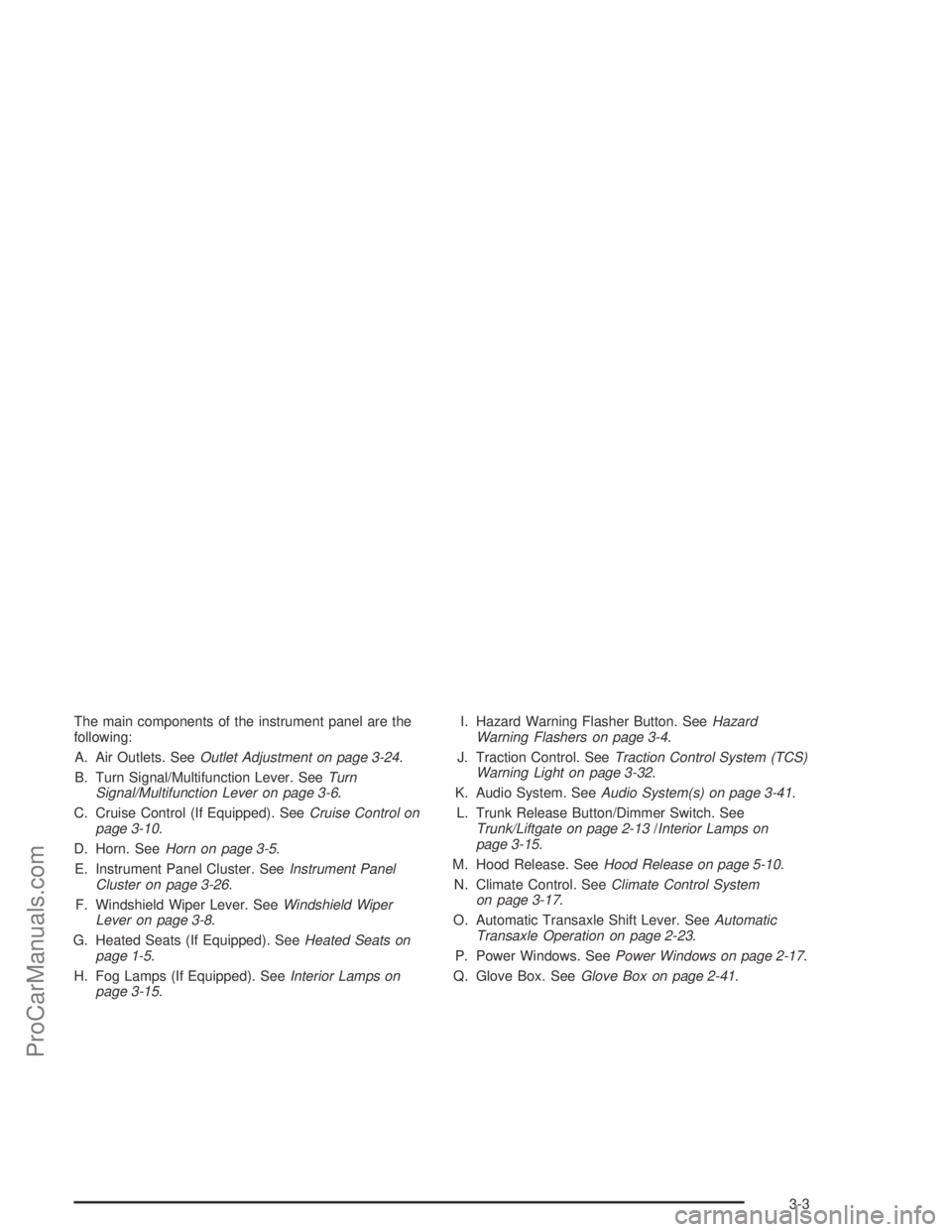
The main components of the instrument panel are the
following:
A. Air Outlets. SeeOutlet Adjustment on page 3-24.
B. Turn Signal/Multifunction Lever. SeeTurn
Signal/Multifunction Lever on page 3-6.
C. Cruise Control (If Equipped). SeeCruise Control on
page 3-10.
D. Horn. SeeHorn on page 3-5.
E. Instrument Panel Cluster. SeeInstrument Panel
Cluster on page 3-26.
F. Windshield Wiper Lever. SeeWindshield Wiper
Lever on page 3-8.
G. Heated Seats (If Equipped). SeeHeated Seats on
page 1-5.
H. Fog Lamps (If Equipped). SeeInterior Lamps on
page 3-15.I. Hazard Warning Flasher Button. SeeHazard
Warning Flashers on page 3-4.
J. Traction Control. SeeTraction Control System (TCS)
Warning Light on page 3-32.
K. Audio System. SeeAudio System(s) on page 3-41.
L. Trunk Release Button/Dimmer Switch. See
Trunk/Liftgate on page 2-13/Interior Lamps on
page 3-15.
M. Hood Release. SeeHood Release on page 5-10.
N. Climate Control. SeeClimate Control System
on page 3-17.
O. Automatic Transaxle Shift Lever. SeeAutomatic
Transaxle Operation on page 2-23.
P. Power Windows. SeePower Windows on page 2-17.
Q. Glove Box. SeeGlove Box on page 2-41.
3-3
ProCarManuals.com
Page 233 of 386

Dinghy Towing
You may dinghy tow your vehicle from the front following
these steps:
1. Set the parking brake.
2. Turn the ignition key to ACC to unlock the steering
wheel.
3. Shift your transaxle to NEUTRAL (N).
4. Open the lid on the underhood fuse block and
remove the IGN 0/3/CR and IGN 1/2 fuses.
Refer to the underside of the underhood fuse block
cover for speci�c fuse locations.
5. Close the lid on the underhood fuse block and store
the two fuses in a safe place.6. Close the hood.
7. Release the parking brake.
Once you have reached your destination replace the
IGN 0/3/CR and IGN 1/2 fuses.
Notice:If you exceed 65 mph (110 km/h) while
towing your vehicle, it could be damaged. Never
exceed 65 mph (110 km/h) while towing your vehicle.
Notice:Towing your vehicle from the rear could
damage it. Also, repairs would not be covered by the
warranty. Never have your vehicle towed from
the rear.
4-33
ProCarManuals.com
Page 247 of 386
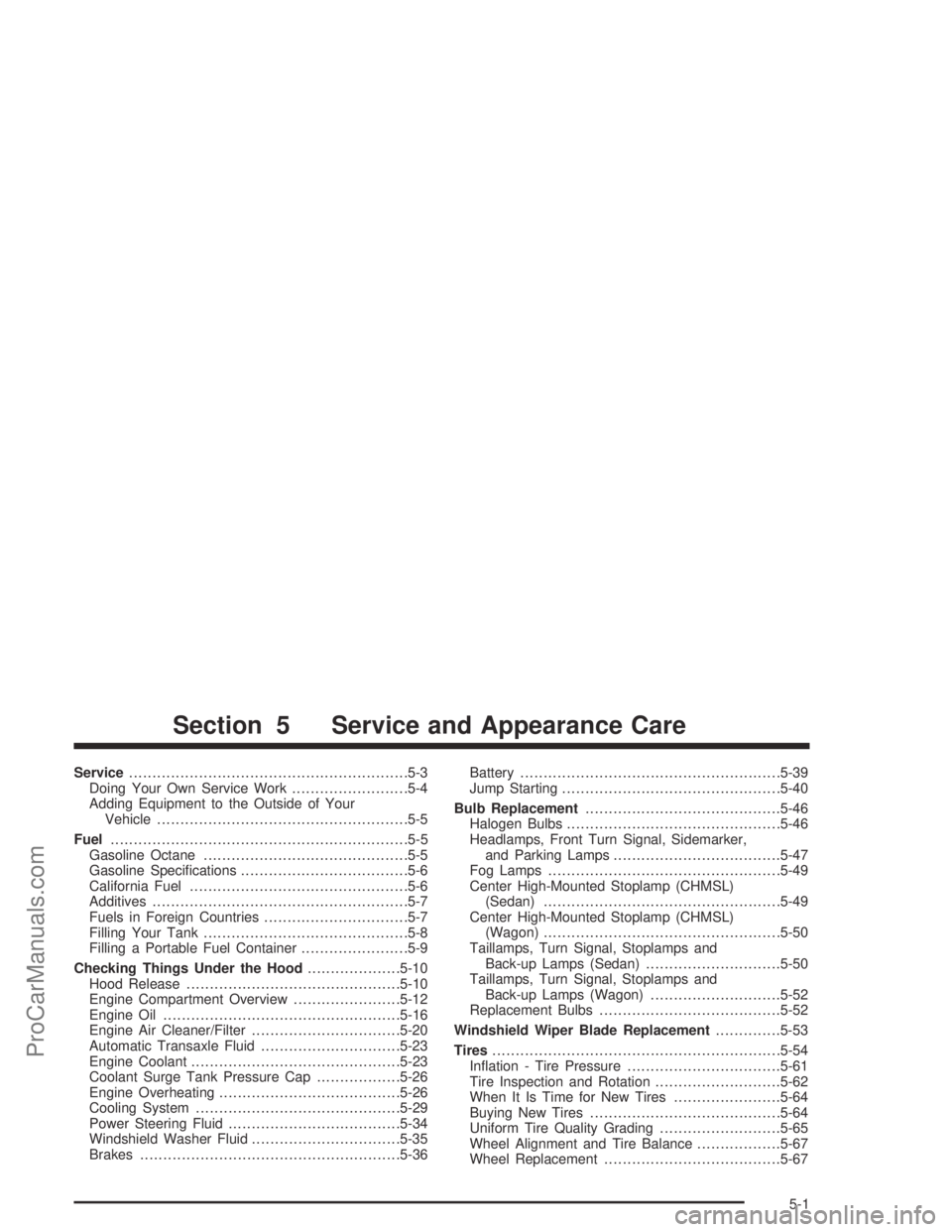
Service............................................................5-3
Doing Your Own Service Work.........................5-4
Adding Equipment to the Outside of Your
Vehicle......................................................5-5
Fuel................................................................5-5
Gasoline Octane............................................5-5
Gasoline Speci�cations....................................5-6
California Fuel...............................................5-6
Additives.......................................................5-7
Fuels in Foreign Countries...............................5-7
Filling Your Tank............................................5-8
Filling a Portable Fuel Container.......................5-9
Checking Things Under the Hood....................5-10
Hood Release..............................................5-10
Engine Compartment Overview.......................5-12
Engine Oil...................................................5-16
Engine Air Cleaner/Filter................................5-20
Automatic Transaxle Fluid..............................5-23
Engine Coolant.............................................5-23
Coolant Surge Tank Pressure Cap..................5-26
Engine Overheating.......................................5-26
Cooling System............................................5-29
Power Steering Fluid.....................................5-34
Windshield Washer Fluid................................5-35
Brakes........................................................5-36Battery........................................................5-39
Jump Starting...............................................5-40
Bulb Replacement..........................................5-46
Halogen Bulbs..............................................5-46
Headlamps, Front Turn Signal, Sidemarker,
and Parking Lamps....................................5-47
Fog Lamps..................................................5-49
Center High-Mounted Stoplamp (CHMSL)
(Sedan)...................................................5-49
Center High-Mounted Stoplamp (CHMSL)
(Wagon)...................................................5-50
Taillamps, Turn Signal, Stoplamps and
Back-up Lamps (Sedan).............................5-50
Taillamps, Turn Signal, Stoplamps and
Back-up Lamps (Wagon)............................5-52
Replacement Bulbs.......................................5-52
Windshield Wiper Blade Replacement..............5-53
Tires..............................................................5-54
In�ation - Tire Pressure.................................5-61
Tire Inspection and Rotation...........................5-62
When It Is Time for New Tires.......................5-64
Buying New Tires.........................................5-64
Uniform Tire Quality Grading..........................5-65
Wheel Alignment and Tire Balance..................5-67
Wheel Replacement......................................5-67
Section 5 Service and Appearance Care
5-1
ProCarManuals.com
Page 256 of 386
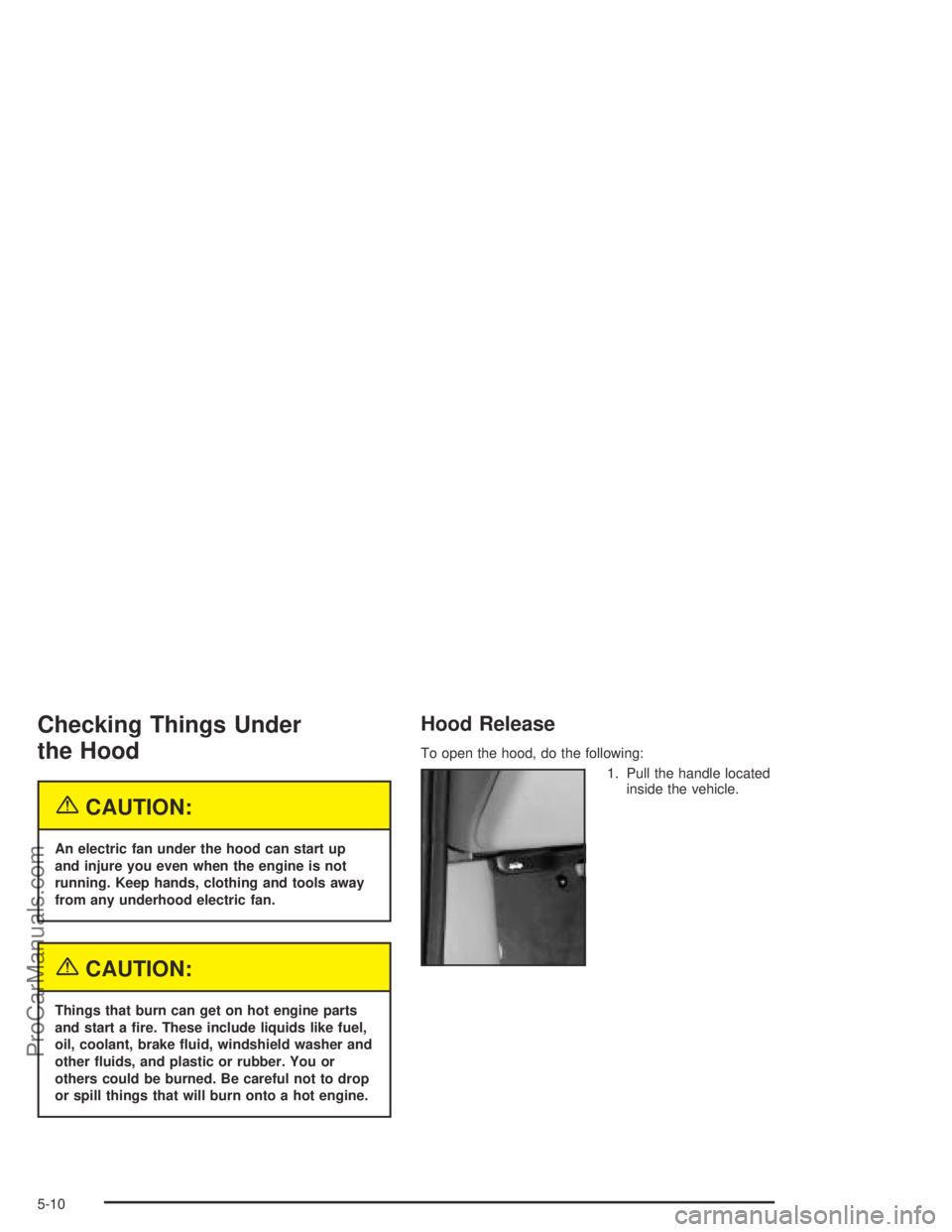
Checking Things Under
the Hood
{CAUTION:
An electric fan under the hood can start up
and injure you even when the engine is not
running. Keep hands, clothing and tools away
from any underhood electric fan.
{CAUTION:
Things that burn can get on hot engine parts
and start a �re. These include liquids like fuel,
oil, coolant, brake �uid, windshield washer and
other �uids, and plastic or rubber. You or
others could be burned. Be careful not to drop
or spill things that will burn onto a hot engine.
Hood Release
To open the hood, do the following:
1. Pull the handle located
inside the vehicle.
5-10
ProCarManuals.com
Page 257 of 386

2. Then go to the front of the vehicle and lift up on the
secondary hood release lever.3. Lift the hood, release
the hood prop from its
retainer and put the
hood prop into the slot
in the hood.
Before closing the hood, be sure all the �ller caps are
on properly. Then lift the hood to relieve pressure on the
hood prop. Remove the hood prop from the slot in the
hood and return the prop to its retainer. Then just let the
hood down and close it �rmly.
5-11
ProCarManuals.com
Page 356 of 386
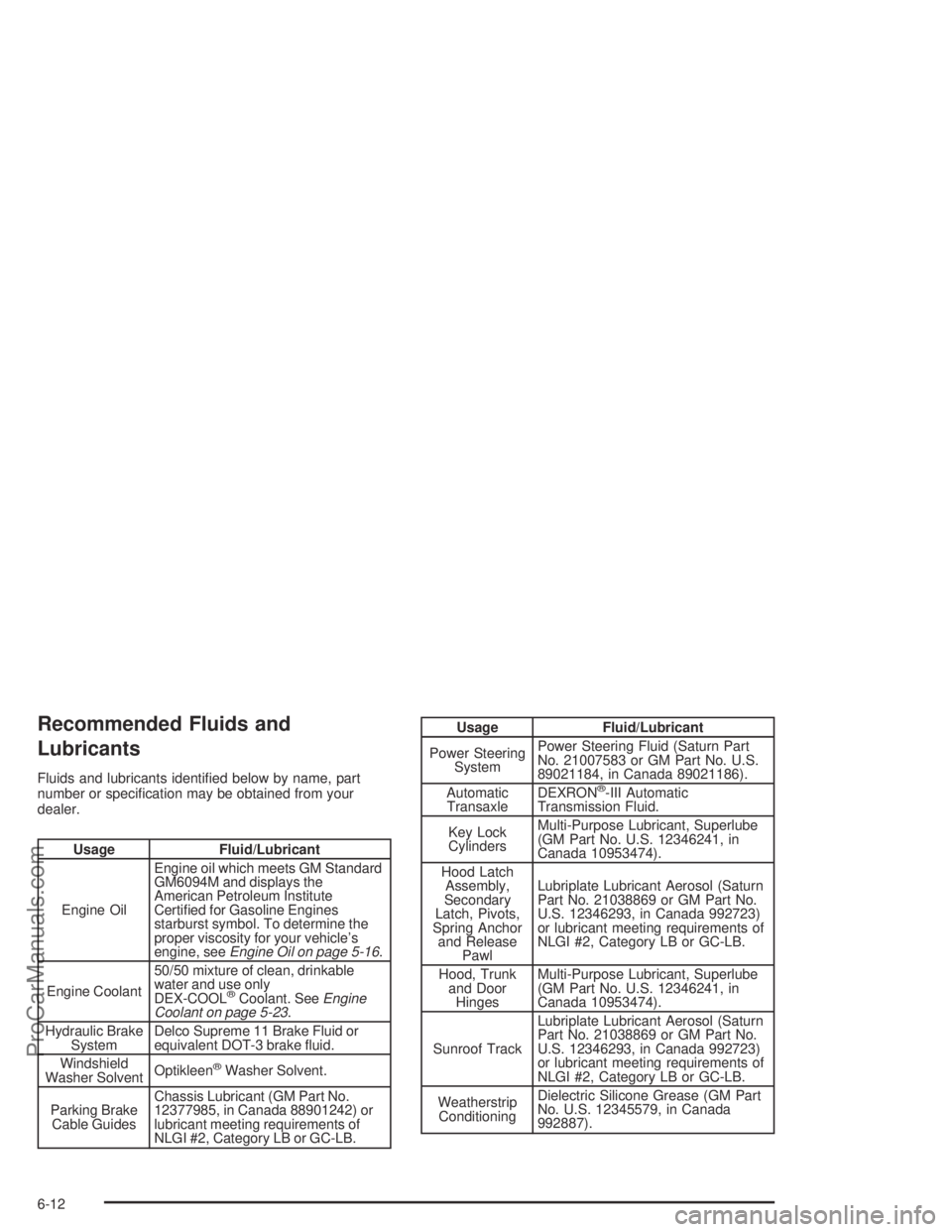
Recommended Fluids and
Lubricants
Fluids and lubricants identi�ed below by name, part
number or speci�cation may be obtained from your
dealer.
Usage Fluid/Lubricant
Engine OilEngine oil which meets GM Standard
GM6094M and displays the
American Petroleum Institute
Certi�ed for Gasoline Engines
starburst symbol. To determine the
proper viscosity for your vehicle’s
engine, seeEngine Oil on page 5-16.
Engine Coolant50/50 mixture of clean, drinkable
water and use only
DEX-COOL
®Coolant. SeeEngine
Coolant on page 5-23.
Hydraulic Brake
SystemDelco Supreme 11 Brake Fluid or
equivalent DOT-3 brake �uid.
Windshield
Washer SolventOptikleen
®Washer Solvent.
Parking Brake
Cable GuidesChassis Lubricant (GM Part No.
12377985, in Canada 88901242) or
lubricant meeting requirements of
NLGI #2, Category LB or GC-LB.
Usage Fluid/Lubricant
Power Steering
SystemPower Steering Fluid (Saturn Part
No. 21007583 or GM Part No. U.S.
89021184, in Canada 89021186).
Automatic
TransaxleDEXRON
®-III Automatic
Transmission Fluid.
Key Lock
CylindersMulti-Purpose Lubricant, Superlube
(GM Part No. U.S. 12346241, in
Canada 10953474).
Hood Latch
Assembly,
Secondary
Latch, Pivots,
Spring Anchor
and Release
PawlLubriplate Lubricant Aerosol (Saturn
Part No. 21038869 or GM Part No.
U.S. 12346293, in Canada 992723)
or lubricant meeting requirements of
NLGI #2, Category LB or GC-LB.
Hood, Trunk
and Door
HingesMulti-Purpose Lubricant, Superlube
(GM Part No. U.S. 12346241, in
Canada 10953474).
Sunroof TrackLubriplate Lubricant Aerosol (Saturn
Part No. 21038869 or GM Part No.
U.S. 12346293, in Canada 992723)
or lubricant meeting requirements of
NLGI #2, Category LB or GC-LB.
Weatherstrip
ConditioningDielectric Silicone Grease (GM Part
No. U.S. 12345579, in Canada
992887).
6-12
ProCarManuals.com
Page 378 of 386
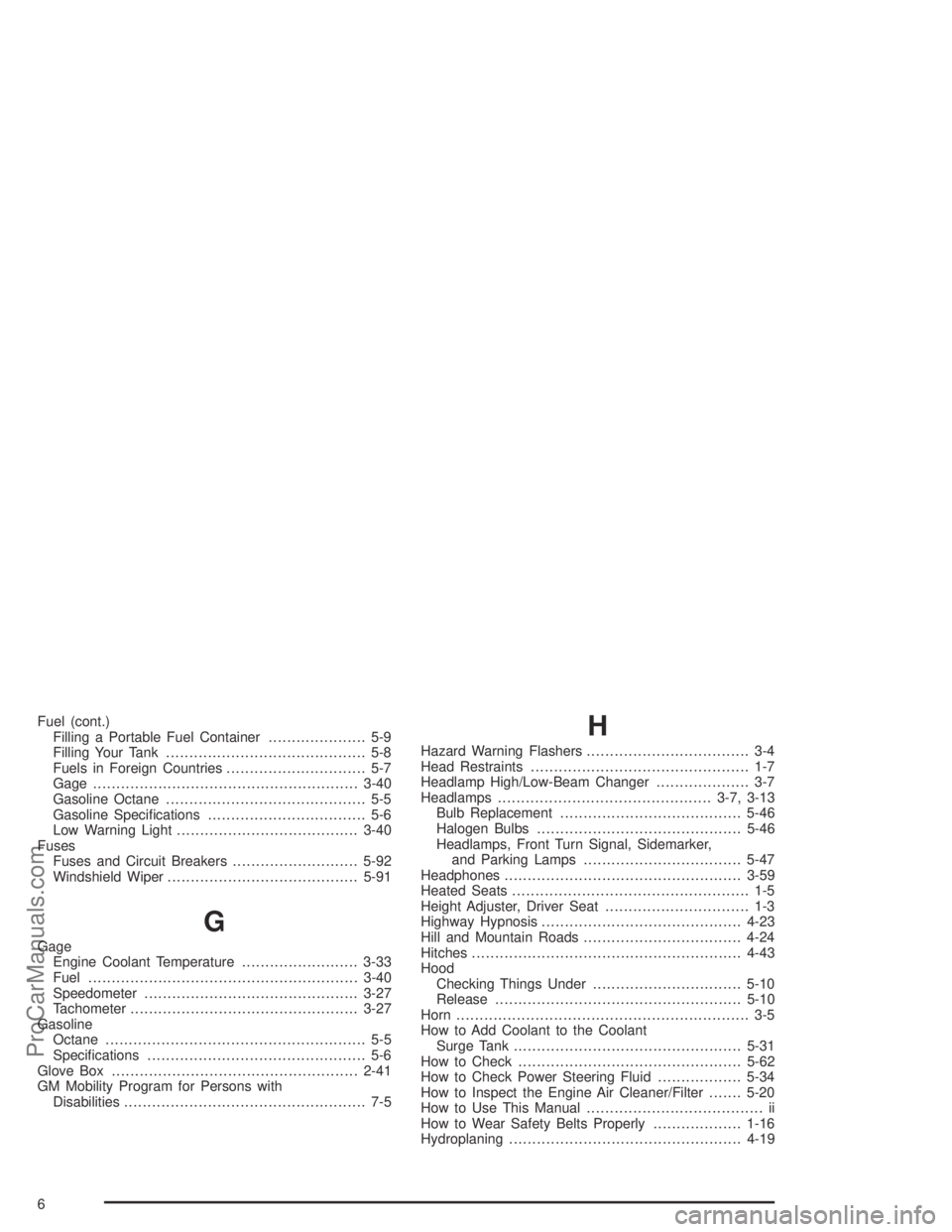
Fuel (cont.)
Filling a Portable Fuel Container..................... 5-9
Filling Your Tank........................................... 5-8
Fuels in Foreign Countries.............................. 5-7
Gage.........................................................3-40
Gasoline Octane........................................... 5-5
Gasoline Speci�cations.................................. 5-6
Low Warning Light.......................................3-40
Fuses
Fuses and Circuit Breakers...........................5-92
Windshield Wiper.........................................5-91
G
Gage
Engine Coolant Temperature.........................3-33
Fuel..........................................................3-40
Speedometer..............................................3-27
Tachometer.................................................3-27
Gasoline
Octane........................................................ 5-5
Speci�cations............................................... 5-6
Glove Box.....................................................2-41
GM Mobility Program for Persons with
Disabilities.................................................... 7-5
H
Hazard Warning Flashers................................... 3-4
Head Restraints............................................... 1-7
Headlamp High/Low-Beam Changer.................... 3-7
Headlamps..............................................3-7, 3-13
Bulb Replacement.......................................5-46
Halogen Bulbs............................................5-46
Headlamps, Front Turn Signal, Sidemarker,
and Parking Lamps..................................5-47
Headphones...................................................3-59
Heated Seats................................................... 1-5
Height Adjuster, Driver Seat............................... 1-3
Highway Hypnosis...........................................4-23
Hill and Mountain Roads..................................4-24
Hitches..........................................................4-43
Hood
Checking Things Under................................5-10
Release.....................................................5-10
Horn............................................................... 3-5
How to Add Coolant to the Coolant
Surge Tank.................................................5-31
How to Check................................................5-62
How to Check Power Steering Fluid..................5-34
How to Inspect the Engine Air Cleaner/Filter.......5-20
How to Use This Manual...................................... ii
How to Wear Safety Belts Properly...................1-16
Hydroplaning..................................................4-19
6
ProCarManuals.com